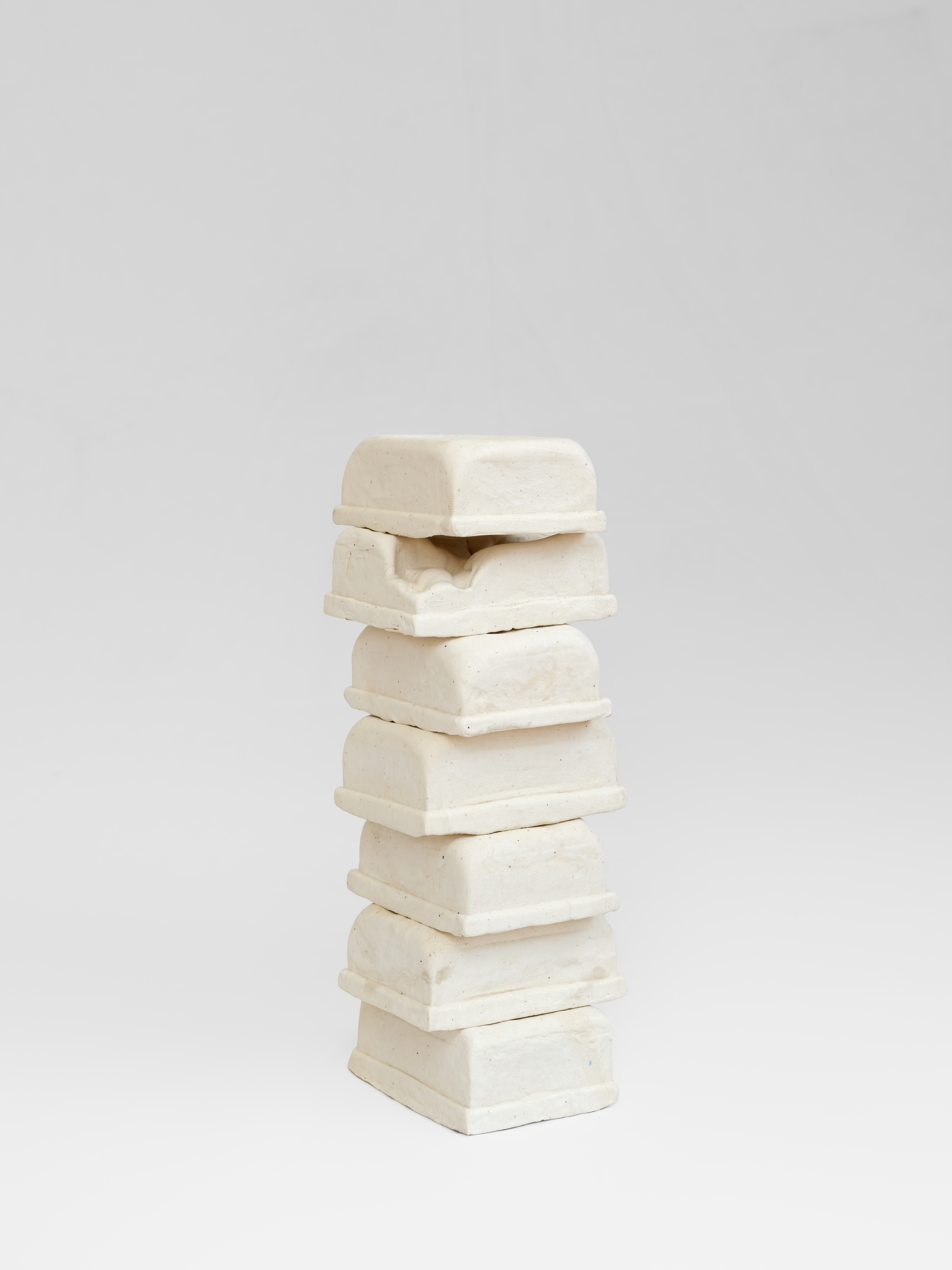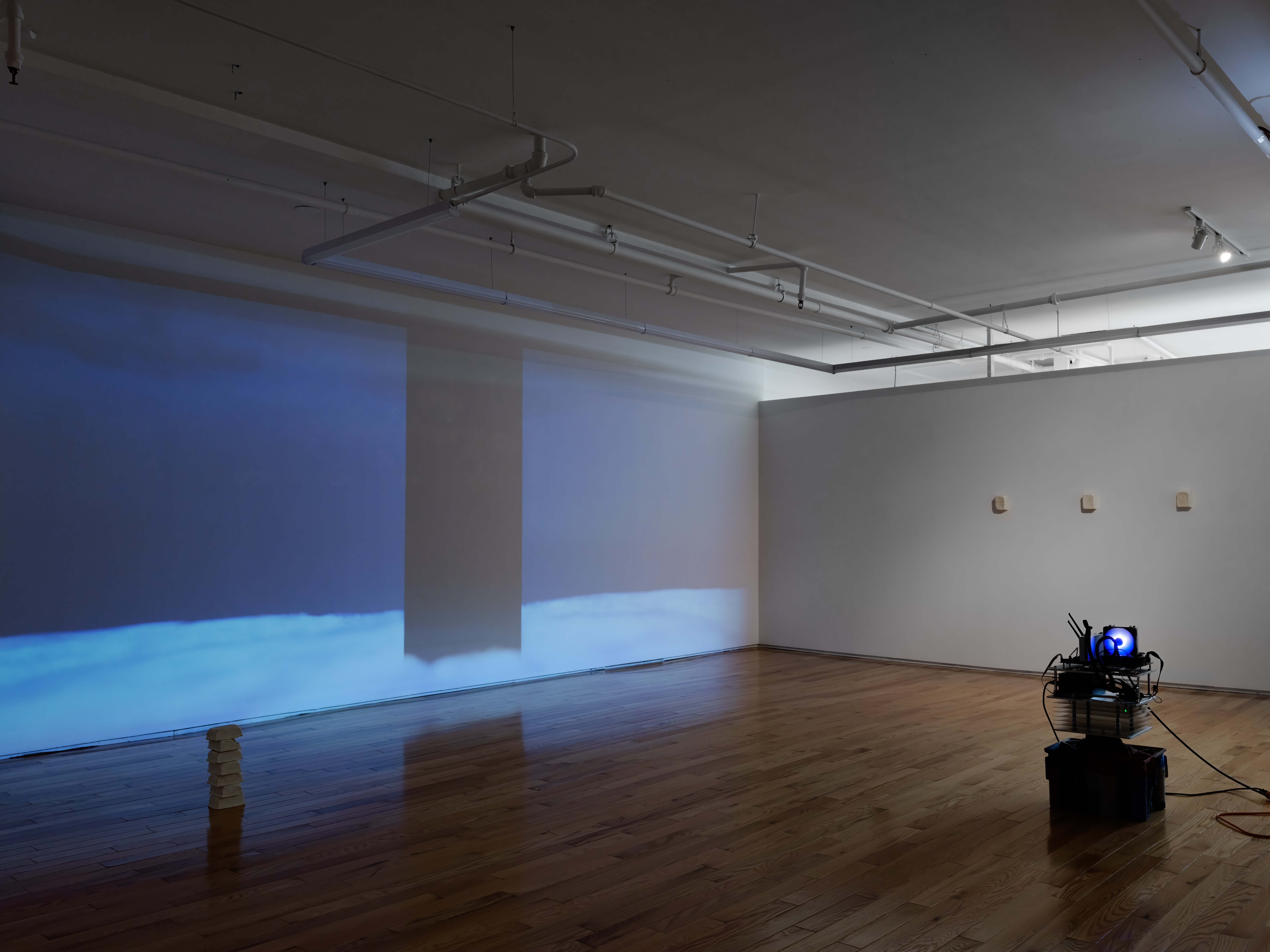formerly: Rubber Factory
full archive here
full archive here
Inflaming Machines is Los Angeles and Kuala Lumpur-based artist Hings Lim’s (b. 1989) first solo show in New York. For this exhibition, Lim assembles recent bodies of work across expanded uses of participatory installation, sculpture, and live simulation. Drawing upon phantasmagoria and nonhuman presences via what the artist calls a “dilation” of everyday technical objects, Lim reimagines our changing socio-cultural relations to “technology”— ancient and imagined—and the performativity of such apparatuses via experiments in materiality. Lim offers the ghostly as a metaphor for in-betweenness in his practice: singular, monumental, and austere forms wax and wane, collapse, ignite and even burn away. The notion of “inflaming” further alludes to a shift towards ecological and environmental concerns in Lim’s practice; the detritus of machines, human consumption, to the burning of land, minerals, fuel, and time.
Stone-age tools and fire serve as technological departure points in Inflaming Machines. Visitors are welcomed by Flaming Tower: what appears to be a translucent stone set aflame atop an aluminum camera tripod is actually a candle cast from the mold of a biface, or hand ax—considered one of the oldest tools in history dating over 300,000 years ago found in caves across the world. These various multiples (cast from 3D replicas of actual flint artifacts in museum collections) recur throughout the show as reminders of the very first hand-held technologies which may have also struck together the first flames. Replaced throughout the duration of the exhibition as they melt, these prehistoric tools are reimagined as durational sculptures, gradually reduced to dripping deposits of multi-colored wax.
The exhibition also includes an arrangement of unlit bifaces grounded on a grooved layer of crating foam, typically used for museum, weaponry, and electric storage. Through the artist’s hand, these once museum artifacts are transformed back into simultaneously technological, functional, aesthetic, and even ritual objects. Visitors are free to pick up a candle (one at a time), light, and set it atop a limestone soapstone platform. Amidst the darkened gallery space and flickering shadows, three seats complete this triangulation of works as participants may devote time to sit with the piece. In an era of digital ocular-centricity and bright screens, we are reminded of the embodied uses of things. This playful mutability of forms for Lim is a contemplation of states of matter in various timescales: geological, human, machine, to decay.
Of the interactive installations in Inflaming Machines, the work Monolith (Polypod) explores the “poly” nature of technology through sound and the representation of machines as indefinite substances. A computer structure with a built-in audio receiver perches on multiple, intricate legs akin to those of a bronze-age Chinese food vessel, or ding 鼎. Every sound made in the space feeds into its antenna and registers into a real-time projection of a whirling cloudscape at dusk, from which a hovering, black monolithic structure emerges. Though rendered to angular perfection, it quivers, ripples, collapses, and disappears altogether in an uncanny dance when stimulated by noise: a body becomes a machine, a machine becomes a body.
The humorous resistance to the monolithic through interchangeable forms also manifests in Tofu Stratum, a new sculptural series of paper pulp cast into industrial-grade molds of tofu stacked atop one another into multiple towers. Some are imprinted with machine parts; negative indentations of gears populate these pieces like the fossilized remains of a rocky outcrop. Here, Lim dredges up childhood memories of growing up at a tofu factory in Malaysia, where cultural and familial expectations prompted one to be productive and instrumental, just like the machines that made the tofu. A cast rubber mold of a generic industrial motor sits on the gallery floor, its negative space also evocative of a biface. Akin to the other soft monuments in the exhibition, these stratums and machine parts serve as personal relics, modern ruins, time capsules, and towers that seem to be in a constant state of collapse. Taken together, Lim challenges the idea of an inevitable technological singularity that pulls us into the gravity of its all-consuming void. Inflaming Machines rekindles the historical roots of the technological continuum and imagines a fractured genealogy of machines.
written by Danni Shen
Hings Lim (b. 1989, Malaysia) is an interdisciplinary artist living and working in Los Angeles. He works in an expanded use of medium that includes video, installation, sculpture, performance, simulation, and situation. His process-oriented practice probes the formation of apparatuses, while addresses the multiplicities between historicity, performativity, materiality, and subjectivity of things and their becoming. He completed a Master of Fine Arts degree and the Performance Studies Graduate Certificate at the University of Southern California, Los Angeles in 2021, as a recipient of the USC International Artist Fellowship; and a Bachelor of Fine Arts degree from the Universiti Malaysia Sarawak, Malaysia in 2012. He is a recipient of the Petronas – P. Ramlee Chair’s Award in 2012 and completed the Southeast Asian Artist Residency Program at Rimbun Dahan, Selangor, Malaysia in 2018. He is currently an artist-in-residence at Grand Central Art Center, Santa Ana, California, supported in part by The Andy Warhol Foundation for the Visual Arts. Selected group exhibitions include ‘The Tale Their Terror Tells’, Lyles & King, New York; ‘Don’t Look Now’, Human Resources, Los Angeles; ‘Wonderland’, EPOCH Gallery, Los Angeles; ‘GLAMFA 2020: Double Play’, CSU Long Beach Art Galleries, Long Beach, California; ‘Young Contemporaries Award’, National Art Gallery, Kuala Lumpur; ‘Art Stage Singapore’, Singapore; and ‘Malaysian Art: A New Perspective’, Richard Koh Fine Art, Kuala Lumpur. He was one of the founders of Lattalilat, a community art project, and exhibited at National Art Gallery, Kuala Lumpur; MIA College Gallery, Kuala Lumpur; FACA Gallery, Sarawak; and Muzium & Galeri Tengku Fauziah, Penang, Malaysia.
Danni Shen is a curator and writer based in Cambridge, Massachusetts. She is currently the Curatorial & Public Programs Assistant at the Carpenter Center for the Visual Arts at Harvard University. Previous curatorial roles include at The Kitchen, Empty Gallery, and Wave Hill in New York. She was also Critic-in-Residence at the Maryland Institute College of Art (MICA), Curator-in-Residence at Residency Unlimited, and has been a visiting critic at NYU-ITP and Cornell AAP. More recent exhibitions include “Off-Worlds” upcoming at YveYANG Gallery in October 2023, "Eating Otherness" at EFA Project Space NYC (2023), "Mediums and Messengers" at Bannister Gallery (2023), "Beast, Chimera, Kin" at the Hessel Museum of Art (2022) and "Collaborative Survival" at 601Artspace (2021). Shen has been a contributor to various artist catalogues as well as publications including BOMB Magazine, Art in America, Heichi Magazine, The Brooklyn Rail, and Hyperallergic. She holds an M.A. from the Center for Curatorial Studies (CCS) Bard College.
Stone-age tools and fire serve as technological departure points in Inflaming Machines. Visitors are welcomed by Flaming Tower: what appears to be a translucent stone set aflame atop an aluminum camera tripod is actually a candle cast from the mold of a biface, or hand ax—considered one of the oldest tools in history dating over 300,000 years ago found in caves across the world. These various multiples (cast from 3D replicas of actual flint artifacts in museum collections) recur throughout the show as reminders of the very first hand-held technologies which may have also struck together the first flames. Replaced throughout the duration of the exhibition as they melt, these prehistoric tools are reimagined as durational sculptures, gradually reduced to dripping deposits of multi-colored wax.
The exhibition also includes an arrangement of unlit bifaces grounded on a grooved layer of crating foam, typically used for museum, weaponry, and electric storage. Through the artist’s hand, these once museum artifacts are transformed back into simultaneously technological, functional, aesthetic, and even ritual objects. Visitors are free to pick up a candle (one at a time), light, and set it atop a limestone soapstone platform. Amidst the darkened gallery space and flickering shadows, three seats complete this triangulation of works as participants may devote time to sit with the piece. In an era of digital ocular-centricity and bright screens, we are reminded of the embodied uses of things. This playful mutability of forms for Lim is a contemplation of states of matter in various timescales: geological, human, machine, to decay.
Of the interactive installations in Inflaming Machines, the work Monolith (Polypod) explores the “poly” nature of technology through sound and the representation of machines as indefinite substances. A computer structure with a built-in audio receiver perches on multiple, intricate legs akin to those of a bronze-age Chinese food vessel, or ding 鼎. Every sound made in the space feeds into its antenna and registers into a real-time projection of a whirling cloudscape at dusk, from which a hovering, black monolithic structure emerges. Though rendered to angular perfection, it quivers, ripples, collapses, and disappears altogether in an uncanny dance when stimulated by noise: a body becomes a machine, a machine becomes a body.
The humorous resistance to the monolithic through interchangeable forms also manifests in Tofu Stratum, a new sculptural series of paper pulp cast into industrial-grade molds of tofu stacked atop one another into multiple towers. Some are imprinted with machine parts; negative indentations of gears populate these pieces like the fossilized remains of a rocky outcrop. Here, Lim dredges up childhood memories of growing up at a tofu factory in Malaysia, where cultural and familial expectations prompted one to be productive and instrumental, just like the machines that made the tofu. A cast rubber mold of a generic industrial motor sits on the gallery floor, its negative space also evocative of a biface. Akin to the other soft monuments in the exhibition, these stratums and machine parts serve as personal relics, modern ruins, time capsules, and towers that seem to be in a constant state of collapse. Taken together, Lim challenges the idea of an inevitable technological singularity that pulls us into the gravity of its all-consuming void. Inflaming Machines rekindles the historical roots of the technological continuum and imagines a fractured genealogy of machines.
written by Danni Shen
Hings Lim (b. 1989, Malaysia) is an interdisciplinary artist living and working in Los Angeles. He works in an expanded use of medium that includes video, installation, sculpture, performance, simulation, and situation. His process-oriented practice probes the formation of apparatuses, while addresses the multiplicities between historicity, performativity, materiality, and subjectivity of things and their becoming. He completed a Master of Fine Arts degree and the Performance Studies Graduate Certificate at the University of Southern California, Los Angeles in 2021, as a recipient of the USC International Artist Fellowship; and a Bachelor of Fine Arts degree from the Universiti Malaysia Sarawak, Malaysia in 2012. He is a recipient of the Petronas – P. Ramlee Chair’s Award in 2012 and completed the Southeast Asian Artist Residency Program at Rimbun Dahan, Selangor, Malaysia in 2018. He is currently an artist-in-residence at Grand Central Art Center, Santa Ana, California, supported in part by The Andy Warhol Foundation for the Visual Arts. Selected group exhibitions include ‘The Tale Their Terror Tells’, Lyles & King, New York; ‘Don’t Look Now’, Human Resources, Los Angeles; ‘Wonderland’, EPOCH Gallery, Los Angeles; ‘GLAMFA 2020: Double Play’, CSU Long Beach Art Galleries, Long Beach, California; ‘Young Contemporaries Award’, National Art Gallery, Kuala Lumpur; ‘Art Stage Singapore’, Singapore; and ‘Malaysian Art: A New Perspective’, Richard Koh Fine Art, Kuala Lumpur. He was one of the founders of Lattalilat, a community art project, and exhibited at National Art Gallery, Kuala Lumpur; MIA College Gallery, Kuala Lumpur; FACA Gallery, Sarawak; and Muzium & Galeri Tengku Fauziah, Penang, Malaysia.
Danni Shen is a curator and writer based in Cambridge, Massachusetts. She is currently the Curatorial & Public Programs Assistant at the Carpenter Center for the Visual Arts at Harvard University. Previous curatorial roles include at The Kitchen, Empty Gallery, and Wave Hill in New York. She was also Critic-in-Residence at the Maryland Institute College of Art (MICA), Curator-in-Residence at Residency Unlimited, and has been a visiting critic at NYU-ITP and Cornell AAP. More recent exhibitions include “Off-Worlds” upcoming at YveYANG Gallery in October 2023, "Eating Otherness" at EFA Project Space NYC (2023), "Mediums and Messengers" at Bannister Gallery (2023), "Beast, Chimera, Kin" at the Hessel Museum of Art (2022) and "Collaborative Survival" at 601Artspace (2021). Shen has been a contributor to various artist catalogues as well as publications including BOMB Magazine, Art in America, Heichi Magazine, The Brooklyn Rail, and Hyperallergic. She holds an M.A. from the Center for Curatorial Studies (CCS) Bard College.















